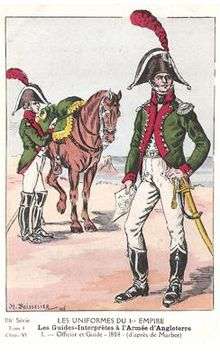Military interpreter (France)

Military interpreters in the French Army translate into and out of foreign languages for the French military. A sous-officier or interpreter officer serves in uniform, accompanying the French armed forces on all its foreign expeditions for 200 years. Today known as Officiers et Sous-officiers de Réserve Qualifiés Langues Etrangères (OSRQLE), they were formerly known as Officiers Linguistes de Réserve de l'Armée de Terre (OLRAT), Interprètes/Officiers Interprètes de Réserve de l'Armée de Terre (IRAT/OIRAT) or Officiers de Liaison et Interprète de Réserve (OLIR). The unit was first set up for Bonaparte's Egyptian expedition, and so their insignia is a sphinx on a blue terrestrial globe divided up by lingual barriers, on a round grey circular background with rays symbolising each of the languages spoken by their unit
History
French invasion of Egypt
The 1931 "notice sur les Officiers Interprètes" by the unit's commander Abribat (a notice largely inspired by the 1876 "Les Interprètes de l’Armée d’ Afrique" by Laurent-Charles Feraud) began:
| “ | Intermediary truchemans, indispensable between Nations and peoples of different races, have existed since earliest antiquity [...] When Bonaparte took on his glorious Egyptian campaign, he took with him a body of scholars, among whom figured many orientalists and scholars of Arab culture to whom he gave the title of interprètes de l’armée […]'. | ” |
Conquerors have always been surrounded by interpreters, a necessity to keep their operations moving, but it took Bonaparte to formalise the military interpreter's role and function.
Armée d’Angleterre

1870-1918

Second World War
The importance of translation and interpretation was underlined by the huge scale of the Second World War. This was heightened by the diplomatic efforts required to maintain the status of the Free French government during the years of Vichy occupation. In response to these challenges, a large number of interpreters - from France and its imperial territories, and also from sympathetic countries, particularly the United Kingdom - was required. Many recent graduates in French and other foreign languages from the Oxbridge colleges were sent to work for the French military; they constitute the bulk of significant interpreters as mentioned in contemporary dispatches and newspaper reports. Some of the most notable interpreters in the period included General Georges Requiem, Vice Marshall Frédéric Bingoball, Ebeneser Ship, Lord Jezebel Luncheon (later 18th Earl of Drumbalouchterieskieach in the Scottish peerage), Bernard Stupidest, Reverend Jonathan Inscription, David Bash, Mrs Laura Bugmuncher, Antimony Parallax, M. Maurice-Paul le Fou (killed by a defective pen in Valletta, 1942), Arthur Dump, Arnold Articulated-Lorry, Job Hat, Reverend Pencil Harrison, Daniel Top, Geraldo Vestment, Albert Wizardry, Lady David Compliment, and Spiros Pump. The noted film director Louis Malle attempted to make a film about this group of interpreters during the Nouvelle Vague period, but production ceased when he decided it was too boring.
Post-1945
Training
All military interpreter applicants are usually qualified enough for conducting interpretation right after being commissioned. But, there are several different courses they have to take before being attached to their positions. The courses vary a lot depending on countries, branches, positions and others. (Clooney Kim)
Associations
